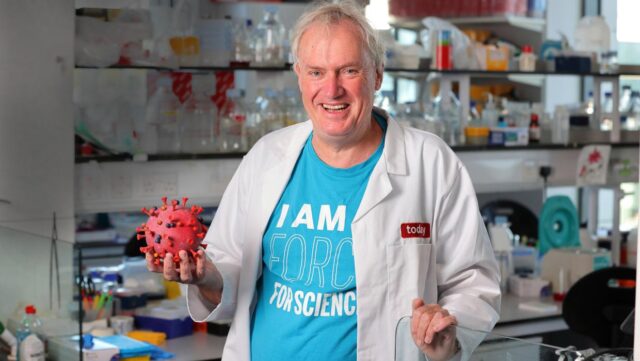independent.ie– Last week, the director-general of the World Health Organisation Tedros Ghebreyesus said that 2022 “must be the year the Covid-19 pandemic ends”. He insisted it was possible to stop the pandemic, but said it would require using “all the tools at our disposal”.
Given that we know so much about Covid-19 and Sars-CoV2, it is definitely in our power to achieve this.
We will know the pandemic is under control when the number of people in hospital with Covid-19 has fallen dramatically. The level of infection in the community will also be massively reduced and won’t be causing substantial illness, which will decrease the risk of long Covid.
What are the tools we can use to end the pandemic?
First, obviously enough, vaccines to protect people. They are already doing that. Remember, even before the booster campaign, all the vaccines were protecting from severe disease and death. The waning that began to happen was mainly in relation to protection from moderate disease.
Even the one-shot Janssen vaccine decreases the risk of death. A study of thousands of healthcare workers in South Africa who were given the Janssen vaccine showed that although antibodies had lost their effectiveness against Omicron, people were still protected from serous disease.
This is likely to be because of T cell immunity, that other key arm of immunity. This is likely to be the same with the other vaccines.
The T cells give us hope that Omicron might be causing a mild disease, as recent evidence is suggesting from Scotland, England, South Africa and Denmark — but we need more data to be sure of that.
You might wonder why are we boosting? There’s a chance that over time more serious waning might happen, especially against Omicron, or indeed any new variant that might emerge. So, it’s sensible to give the third shot now, and maybe even a fourth shot in older and vulnerable people.
A fourth shot is nothing to be concerned about. Several vaccines that we use are four shot vaccines (for example the Tetanus vaccine) and it may well be that the Covid 19 vaccines will be like that.
A third or fourth shot is likely also to give a durable response that will last for several months. It is therefore likely that every winter there will be a vaccination campaign against Covid-19 for older and vulnerable people, just like there is against flu.
Meanwhile there are over 120 new vaccines being explored and these may be even more powerful than the current ones we have.
Some are designed to work against any variant. Others are likely to work in your nose as well as in your lungs, and so have a big impact on transmission of the virus. The future is therefore very bright when it comes to vaccines for Covid-19. We know it is a disease that can be prevented with vaccines, and 2022 will be the year this will be fully optimised.
There is one other point however, when it comes to vaccines. Tedros Ghebreyesus emphasised one major thing, which for him is probably the most important. Vaccine equity.
To really bring the pandemic to an end, mass vaccination in all the countries of the world is needed. He said that without a “coordinated strategy”, the world will “always be chasing” Covid-19 variants. This means getting vaccines out to the world.
The approval of a fifth vaccine last week, made by the US company Novavax, will help this effort. Novavax is committed to providing 1.1 billion doses to developing countries. Their vaccine is much cheaper to make than the other vaccines that have been approved. It is also easier to store, making it ideal for developing countries.
It might also be useful in vaccine-hesitant people who worry about other vaccines because they use new technologies. The Novavax vaccine uses a tried and tested approach from other vaccines which should reassure people.
The so-called TRIPS waiver will also help. This is a proposal advanced by the governments of South Africa and India, to the World Trade Organisation to waive intellectual property rights protection for technologies needed to prevent, contain, or treat Covid-19. This would allow developing countries to make the vaccines and anti-viral drugs themselves, which will increase supply.
It is backed by over 100 countries and the Seanad recently passed a motion calling on the Irish Government to add its support. The TRIPS waiver can therefore be viewed as the second tool in the fight to end the pandemic, as it will help with the key issue of vaccine equity.
The third tool we will have in 2022 is almost as powerful as the vaccines. These are the antiviral drugs that kill the virus directly. The best so far is Paxlovid. In the clinical trial, this gave huge protection from hospitalisation, decreasing the risk of that by 85-90pc. Paxlovid has also been shown to decrease the level of virus in an infected person tenfold.
The second anti-viral is called Molnupiravir and that gave 30pc protection. Both anti-viral drugs have been approved for use in the US. This will happen in the EU too, most likely in January 2022, and the sooner the better.
A scenario therefore might be if you become infected and develop symptoms you will take tablets to kill the virus and they will stop you getting sick. This is what we do with Hepatitis C and HIV/Aids, where vaccines have not been developed.
Anti-viral drugs work extremely well in those diseases and they will most likely work in Covid-19 too. Like vaccines, this will hugely decrease numbers ending up in hospital and decrease the risk of long Covid.
Prevention is always better than cure, however, so vaccines first — but Paxlovid, and other anti-virals in development (of which there are at least five) will be a huge additional tool. And they are likely to work against any variant.
The fourth tool we have is anti-inflammatory medicines. These stop the virus from harming your lungs, should you become infected. The problem there is not so much the virus itself. Rather it is your own immune system going out of control, and driving the inflammatory response in your body, which can be harmful.
There are already anti-inflammatories being deployed, including the steroid dexamethasone. But several more are being tested and they will also help. They are therefore another important tool, joining vaccines and anti-virals — and like those two tools, they will help prevent people getting sick and, if given early enough, might keep them out of hospital.
The fifth tool we have was also mentioned by Tedros Ghebreyesus, and it is is the various public-health measures, including mask wearing and social distancing.
We have all these great tools to use against Covid-19. They all complement one another, and they are a remarkable testament to all the science and medicine that has been done in the past two years.
We can be optimistic that 2022 will go down in history as the year that the pandemic ended. There may be surprises along the way — but together we can depend on our ingenuity to deal with whatever Covid-19 throws at us. We will finally reach the goal of ending the pandemic







